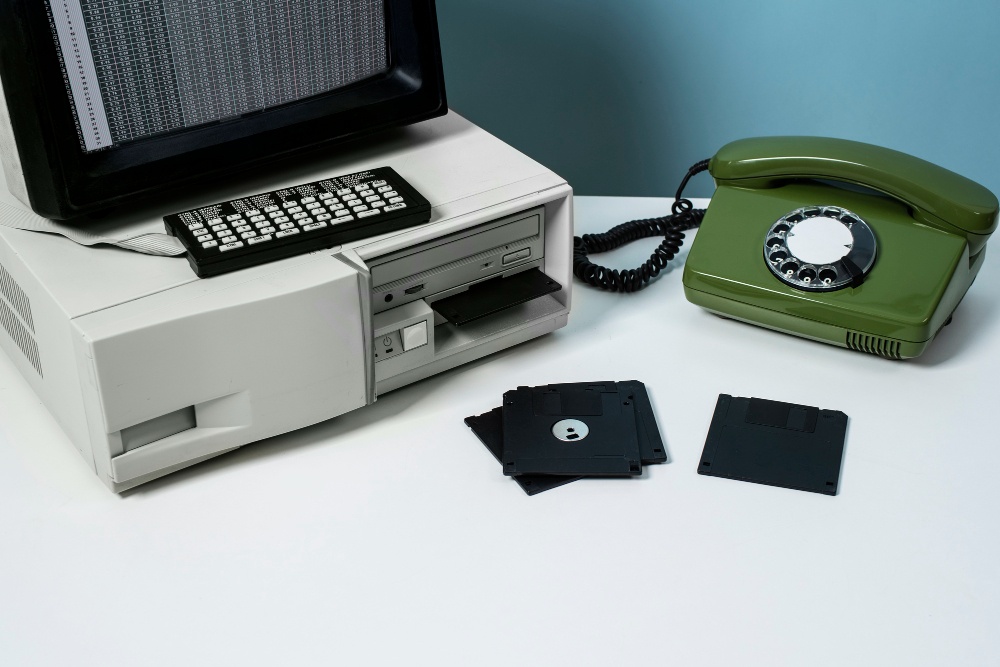
Let’s be honest: most business owners don’t wake up one morning thinking about old hardware and saying: “You know what we need? A five-year plan to keep using that printer from 2008.”
And yet… here we are.
Offices all over the UK are still running on ancient copiers, dusty PCs, and hardware that makes a dial-up modem look cutting edge. Why? It’s rarely about love for the machine – it’s more often about fear, habit, or budget.
So let’s talk about why people cling to legacy hardware – and what you can actually do about it (without blowing your IT budget or causing a staff revolt).
“If It Ain’t Broke…” (It’s Still Probably Costing You a Fortune)
First things first – yes, the old kit might still technically “work.” That printer turns on. That PC boots. That server hasn’t exploded (yet). But just because something works doesn’t mean it’s working well – or safely.
Still, most people hold off on replacing legacy hardware because of a few very understandable reasons:
1. Cost Paralysis
Upfront costs can be a killer. Buying new gear, training staff, installing software – it all adds up. Even if you know the old system is dragging you down, the price tag of replacement can stop the conversation before it starts.
We’ve worked with plenty of SMEs who delayed upgrading for years because the quotes looked scary. But once we broke it down monthly and compared it to current maintenance, ink, and energy costs? The upgrade actually saved money.
2. Fear of Disruption
What if it breaks something? What if the new thing doesn’t work? What if the team hates it?
Businesses often worry that upgrading will cause more chaos than it’s worth. Especially if the old system is tied into some fiddly software or quirky workflow that only Doris in finance understands.
3. “It’s Familiar – Leave It Alone”
There’s a kind of comfort in old systems. People know their way around them. No training, no confusion. No one accidentally printing 87 copies of a spreadsheet they didn’t mean to open.
The idea of changing it – even for something better – can feel more hassle than it’s worth.
4. Bespoke Software or Weird Setups
Sometimes you’re stuck because of legacy software or a custom setup that only works with that specific model of printer or hardware. Replacing it means reengineering the whole thing – and that’s not cheap.
5. Lack of Time or Expertise
For a lot of businesses – especially smaller ones – there’s no in-house IT team to make these decisions. It’s just someone wearing ten hats who doesn’t have the bandwidth to research, plan, and manage a hardware refresh.
So the “do nothing” option wins by default.
So What Can You Actually Do About It?
You don’t need to overhaul everything overnight. No need to send a skip to the server room. But you do need a plan. Here’s how to start moving things forward without giving your finance team a heart attack.
✅ 1. Schedule Regular Hardware Reviews
Once a year, look at what you’re using. Is it still supported? Is it compatible with current systems? How often is it breaking? You can’t fix what you don’t track.
One client discovered they had six printers – but were only using two. The rest were just being patched up “just in case.”
✅ 2. Use Phased Upgrade Cycles
Replace in stages. Start with the worst offenders – the machines that break most often or cost the most to run. Spread the cost over time and reduce the risk of disruption.
✅ 3. Isolate Risky Legacy Devices
Still got ancient tech hanging around? Stick it on a separate network if you can. That way, if there’s a security risk, it doesn’t have access to the whole system. Think of it like putting it in a digital quarantine.
✅ 4. Consider Refurbs or Hybrid Setups
You don’t always need shiny and brand new. Refurbished hardware or hybrid cloud/physical solutions can save a ton while still offering major performance boosts. Especially for non-critical roles.
✅ 5. Bring in External Help
IT consultants or managed service providers can take the stress out of it. They’ve seen it all before, know the pitfalls, and can help you plan things properly – including budgeting, staff onboarding, and making sure your new stuff actually works with your existing tools.
✅ 6. Pilot, Don’t Panic
Before a company-wide change, test new hardware in one department or team. It builds trust, lets you iron out issues, and gives you a group of staff who can champion the new kit to others.
✅ 7. Shift the Conversation
This is the big one. Start talking about cost of inefficiency, not just the sticker price of new hardware. What are you losing in downtime? Staff frustration? IT resources? Data risk?
Once leadership starts seeing old hardware as a liability instead of a money-saver, things change fast.
Final Thought: “Still Works” Is Not a Strategy
Yes, keeping that decade-old copier might feel like saving money today. But chances are it’s costing you more than you realise – in time, security, energy, and lost productivity.
Modernising doesn’t have to be painful, expensive, or all at once. But it does need to start.
So if you’re still babying that flaky old printer, consider this your permission slip to say: “We deserve better.”
Need help building a case to replace your legacy hardware?
We’ve helped businesses of all sizes put together cost comparisons, phased upgrade plans, and realistic timelines that actually stick. Just ask.




